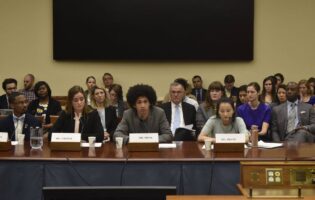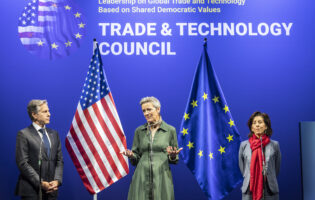The U.S. and German Approach to Non-Proliferation: Influencing States’ Decisions to Acquire Nuclear Weapons

Antje Nötzold
Chemnitz University of Technology
Dr. Antje Nötzold is a Research Associate and Lecturer in the Department of International Relations at Chemnitz University of Technology. Additionally, she receives a scholarship for her habilitations thesis from the Konrad-Adenauer- Foundation. She is a member of the Working Group of Young Foreign Policy Experts of the Konrad-Adenauer-Foundation and has participated in the Expert Advisory Group “European and South Mediterranean Actors – Partners in Conflict
Prevention and Resolution,” the Manfred Wörner Seminar, organized by the Federal Ministry of Defense and the German Marshall Fund, as well as the International Visitor Leadership Program of the U.S. State Department.
Dr. Nötzold holds a PhD in Political Science from the Chemnitz University of Technology and a Magister degree with a double major in political science and business administration. In her dissertation, “The energy policy of the EU and the People’s Republic of China. Implications for European Supply Security,” published in 2011, she analyzed the characteristics of common EU and Chinese energy policies and their respective priorities. The dissertation also identified the interdependencies of both consumers through policies and markets with regard to securing supplies.
Nuclear proliferation is not a diminishing problem; rather, it possesses an increasingly significant threat to global security in the twenty-first century. The United States and Germany are committed to the principle of non-proliferation and promote a strengthening of the non-proliferation regime. Both are characterized by different levels of leverage to influence states’ nuclear decisions. Nonetheless, they do not yet tap the full potential for a concerted approach. Whereas the U.S. will remain essential to offset security threats and for credible security guarantees, Germany—within the European framework—should become more active to promote further diplomatic initiatives in this field. Furthermore, a coherent approach should not only focus on the current outlier cases of Iran and North Korea, but should incorporate a long-term strategy for a non-proliferation norm lived worldwide and a global consensus on related obligations.
Causes Of and Influence On Nuclear Decisions
Political decisions and mechanisms to deter or counter proliferation are based on assumed causes that encourage the establishment of a nuclear program and possibly propel it on the path toward developing nuclear weapons. So the starting point should be to scrutinize states’ motives in order to adjust incentives and constraints directing the future of a state’s nuclear program. Since the mid-1990s, studies have identified a wide range of possible causes and factors of nuclear proliferation,[1] which offer a wide spectrum of potential measures to influence states’ nuclear decision-making. Building on their results, several important aspects have to be taken into consideration when addressing proliferation issues:
- First, nuclear proliferation has to be differentiated into two related but distinct stages—the presence of a nuclear program, which is capable of producing nuclear weapons, and the actual possession of nuclear weapons.[2] The assumption that the goal of any nuclear program is to acquire nuclear weapons narrows both the assessment and the political options toward possible proliferators. The ambiguity of nuclear proliferation suggests that it should be viewed as a process by which countries move closer to or away from different thresholds in developing the bomb.[3] There are more gradations in a state’s aspiration with its nuclear program beyond sole civil usage or a nuclear arsenal.
- Second, multi-causality lies at the heart of the nuclear question as proliferation or renunciation occurs for more than one reason and the impact of each factor varies case-by-case. Thus, prospects for success are deeply tied to a wide range of domestic as well as international issues.
- Third, success or failure of external influences on the path of a state’s nuclear program are related to appropriate and coherent incentives and constraints based on the right assumptions of underlying causes and the aspirations of the government.
Nevertheless, success sometimes relies particularly on an open window of opportunity. Hence, when dealing with critical nuclear programs and potential proliferators it is important to maintain diplomatic involvement and keep communication channels open to buy time, waiting for external or internal constellations to offer opportunities for a diplomatic breakthrough.[4] External actors should take into consideration that not only tailored incentives and constraints matter, but also perception and opportunity. To put it bluntly: It’s not only what’s on the table that is decisive, but also who talks with whom and when.
Lessons Learned from Past Cases of Proliferation or Rollback
Since the first atomic bomb was assembled, nine states have acquired nuclear weapons, while at least nineteen states[5] enacted—partly voluntary, partly forced—a sustained reduction in intent or capability to develop or maintain a nuclear weapon capacity. Some had merely pursued modest research efforts before reversing course; others ultimately gave up fully constituted nuclear weapons. Upon examination, each case offers different insights into the decisive external influences and domestic changes. However, the following aspects seem crucial for determining the appropriate direction and the right time for external influencing:
- First, external actors should empathize with the other country’s perspective. They have to take the country’s security concerns seriously to create effective attempts to alleviate them.
- Second, the individual mindsets of ruling politicians and other responsible actors of the nuclear program are important, especially since a change of attitude toward nuclear restraint was often associated with a change of government or leadership.
- Third, the role of the military in nuclear programs should be diminished by promoting civilian rule and control.
- Fourth, proponents of openness to the outside world and of integration in the international order and economy are less likely to seek nuclear weapons than governments wanting to shut the world out. Those would also be less vulnerable to international isolation.
Each state certainly made the decision to renounce for a variety of reasons. Foremost among them was the desire to improve their international standings[6]—in terms of security, economy, and prestige. However, those successful cases of countering proliferation happened when the international system was quite different from today. Nuclear restraints in the 1960s and 1970s and the abandonment of nuclear weapons in the 1990s was facilitated by particular circumstances. Today, the international community is faced with more opposition to a Western-led establishment and interpretation of international norms, as well as changing ideas about sovereignty.[7] Some critics even go one step further and generally challenge the universality of international norms established by a Western-led society.
These developments challenge a coherent international position toward different manifestations of nuclear proliferation and undermine the application of another important factor: foreign pressure. Here, the importance of the United States in influencing past nuclear rollback decisions must be highlighted. Not only was U.S. policy central to encouraging nuclear restraint among its allies and partners, but it is also likely to remain significant to ensure that they do not resume their programs. Thus, the U.S. effectively influenced rollbacks or restraints, when it was in the position to offset security threats. Conversely, if the U.S. itself is perceived as a security threat, then there is little incentive for regimes to make concessions. So, the “U.S. role in global politics is likely to be a major determinant of the ultimate pace of proliferation. If threshold states perceive the United States either as an antagonistic power or as an unreliable ally, they are more likely to pursue independent nuclear weapons programs.”[8] Furthermore, the importance and the influence the U.S. exerted during the Cold War and the unipolar era in the 1990s is contested by China, and other emerging (regional) powers, today.
Current Crucial Issues for Effective Non-Proliferation Policy
Non-proliferation efforts have to take into account that nuclear rollback is a slow and complex issue and no country followed a clear linear decline in intent or capability. The ambiguity of nuclear programs contains the option to delay the decision about acquiring or restraining nuclear weapons—at least publicly—until the last possible moment. Thus, nuclear rollback has to be approached as a process, not as a permanent outcome.[9]
The international community faces a lack of coherence in the interpretation of respective rights and obligations of the nuclear weapon states (NWS) and the non-nuclear weapon states (NNWS) within the Treaty on the Non-Proliferation of Nuclear Weapons (NPT) and, as such, the extent of required rollback is highly disputable and susceptible to complaints of double standards. Several NNWS operate nuclear programs that contain a breakout capacity[10], but are nonetheless accepted by the international community. As a result, many emerging countries such as Brazil, South Africa, or Turkey refuse to forego the right of the NNWS to master all components of civil nuclear energy usage, including a complete fuel cycle. This means the NPT is faced with a North-South gap, which continues to grow. Many threshold states and nuclear energy aspirants believe the NPT already benefits the NWS disproportionally and oppose additional non-proliferation policies and constraints for NNWS.[11] This undermines the credibility of the NPT and non-proliferation norms.
Proliferation policy should not only focus on the outliers of the non-proliferation regime, but should also consider the impact of threshold states and energy aspirants. Breakout capacities have destabilizing effects on security issues and might already encourage proliferation dynamics. The future non-proliferation agenda should persuade states embarking on nuclear energy programs to adopt comprehensive transparency measures that increase confidence in their peaceful intensions.
So, non-proliferation policy should aim at more than just stopping states from actually acquiring a nuclear bomb and take a closer look at the first stage, i.e., the establishment and progress of nuclear programs. Nuclear assistance, especially with regard to sensitive technology and fissile material, is a crucial factor to proliferation.[12] While the Cold War superpowers were able to diminish or promote nuclear programs through technology denial or assistance, “More recently, this role has been played by second- and even third-tier states, such as […] Pakistan, and North Korea.”[13] Consequently, without an inclusion or at least binding commitment of those countries to the rules of technology exports of the Nuclear Supplier Group, technology denials are hard to be implemented effectively. Regulated technology transfers and enhanced export controls are indispensable to limit the spread of sensitive capabilities like uranium enrichment, plutonium processing, and the design and construction of nuclear weapons. However, transparency and safeguard mechanisms need to be strengthened. The enforcement of the Additional Protocol of the International Atomic Energy Agency (IAEA) safeguard agreement is just one element of enhanced transparency and confidence building. In the long term, only new concepts like multinational fuel-cycle facilities or an internationalization of fissile material production in combination with reliable supply assurances would persuade states to forego national facilities and decrease the spread of breakout capacities.
U.S. and German Approaches
Both the United States and Germany are members of the NPT and have obliged themselves to promote non-proliferation norms and counter further nuclear proliferation. However, their policy approaches reveal differences in regard to their preferred methods to address proliferation issues. This becomes especially obvious with regard to the use of military forces: The U.S. shows an openness to solve foreign policy problems through military means. Germany emphasizes non-military solutions. The German government is very reluctant to use military forces and instead stresses diplomatic prevention—focusing on international norms, trade agreements an changes in the domestic politics of those countries—and reserves coercion as the last resort. Even then it should be administered only according to international law with a UN Security Council resolution under Chapter VII of the UN Charter. The European policy in response to the revelations on Iran’s nuclear program are an example of German non-proliferation strategy: Europe’s response to the 2003 IAEA findings was to pursue a soft power policy of conditional engagement based on the belief that isolation and punishment would not work.[14] Without the option of posing a credible threat to the security of the Iranian regime, Europe’s emphasis on non-military solutions is also out of necessity. While the U.S. had overthrown two unpleasant regimes in the neighborhood of Iran, European countries do not lack the military capabilities to conduct an effective military strike.
U.S. policy in the twenty-first century has shown a tendency toward more aggressive interventions, culminating with the George W. Bush administration declaring coercive diplomacy, embargoes as well as military strikes, and preventive war as core elements of its national strategy toward non- and counter-proliferation.[15] Nevertheless, the option of limited military strike does not apply to advanced nuclear programs like those of Iran or North Korea, and today the credibility of the threat of a U.S. comprehensive military intervention is at least questionable—despite rhetoric that this option is still on the table. Although the U.S. conducted military strikes against Iraq and Afghanistan, its credibility for future military action is undermined by the problems it faced after the two invasions as well as by the current reluctance to intervene against chemical weapons deployment in Syria—despite claiming it as a red line.
President Barack Obama launched significant changes to the U.S. nuclear policy and its disarmament commitments. As the first NWS and—together with Russia—the state with by far the most nuclear warheads, the U.S.’ non-proliferation policy is always perceived in relation to its disarmament efforts. In his speech given in Prague in 2009, Obama referred to the idea of “Global Zero” as a long-term goal. Hosting the 2010 Nuclear Security Summit, together with the Nuclear Posture Review and the “New Start” nuclear arms reduction treaty (which the U.S. and Russia agreed on), showed his seriousness. The 2010 Nuclear Posture Review reduced the role of nuclear weapons in deterrence. Furthermore, the administration declared that the United States will not use or threaten to use nuclear weapons against NNWS that are party to the NPT and in compliance with their nuclear nonproliferation obligations.[16] This automatically provides negative security assurance to all states bound to international non-proliferation norms.
It could be concluded that the key objective of the U.S. policy toward outliers of the non-proliferation regime is putting them in the position where they have to make a strategic decision: Do they want to be part of the international community or do they want to be (further) isolated.[17] This applies to its policy toward Iran—as well as to earlier cases like the former Soviet republics, Libya, or Iraq. However, this requires an international community speaking with one voice based on a strong non-proliferation norm and a consistent commitment of all NPT members. The U.S. promoted many initiatives, including the Nuclear Suppliers Group, the Proliferation Security Initiative, and the NPT itself, to pursue non-proliferation and to accelerate the securing of nuclear materials worldwide. However, others are deadlocked, like the ratification of the CTBT,[18] the FMCT,[19] and additional nuclear disarmament agreements. Furthermore, many NNWS share skepticism over the motives of the current U.S. disarmament drive, perceiving it as only a tactical element rather than conviction and are starting to question the NPT’s equality of rights and duties for the nuclear and non-nuclear weapons states.
The United States and its partners in nonproliferation diplomacy share many of the same interests while economic, diplomatic, normative, and military leverage are unevenly distributed between the U.S. and Germany. Differences of interests and diplomatic philosophy could create obstacles in pursuing a coordinated approach, especially in the early phase of a proliferation issue—as the case of Iran exemplified. Nevertheless, it would be oversimplifying to reduce them to differences between a more unilateral, militarized, and strategic United States and a more multilateral, pacifist, pragmatic, and pluralist Europe.[20] However, their differences do not necessarily have to be detrimental, but, rather, could be utilized to enhance a coherent approach.
Recommendations for a Coherent Approach
In light of the NPT review conference in 2015, both the U.S. (a NWS) and Germany (an important NNWS) should promote a new global consensus on non-proliferation, which should take the following elements into appropriate consideration:
- improved balancing of the NPT’s three pillars of non-proliferation, disarmament, and support for civil use of nuclear energy;
- the rights and the responsibilities of peaceful nuclear programs in line with adequate and effective verification mechanisms depending on the degree of technological advancement; and
- universality, meaning joint efforts to include the holdouts in a global consensus.
But, like every regime, the non-proliferation regime requires leadership. While the role of superpowers will remain one of the most important variables in determining the pace of proliferation, the changing structure of the international system and accompanying power shifts require a broader base for an non-proliferation norm lived worldwide. Nonetheless, both the U.S. and Europe have been more focused on domestic politics recently and do not seem to have the luxury of time for strategic thinking on long-term issues like non-proliferation. However, they still have shared values, shared capabilities, and shared problems and should seek to improve a coherent and common transatlantic approach.
The cooperation between the U.S. and Germany already works in strengthening the NPT using diplomatic tools, the NPT review process, and in advocating for nuclear non-proliferation. Furthermore, both seek to turn the emerging powers into responsible stakeholders in the institutions of the existing world order. However, more initiatives to strengthen and promote the non-proliferation regime should emanate from Europe. Some possible initiatives include a re-launch of the negotiations for a FMCT, with an alternative forum to negotiate with countries, who are in favor of it; or the promotion of further Weapons of Mass Destruction Free Zones, especially in the Middle East—now with Syria joining the Chemical Weapons Convention and hope for progress in the Iranian nuclear crisis—and could be considered for Europe, to lead by example. In the both initiatives, Germany could play a leading role as a credible NNWS with an exemplary standing on safeguard and verification issues, its economic strength, and its credible multilateral attitude.
An ongoing challenge is the Iranian nuclear conflict, for which the transatlantic partners established a common approach. When the EU3 format expanded to the P5+1 and the U.S. was more involved in the negotiations with Iran, they developed an effective joint carrot-and-stick strategy. However, when it comes to the two crucial elements of proliferation decisions—the question of standing within the international community and the security environment—the U.S. has to play a leading role. A sustainable solution would require recognition of the legitimacy of the Iranian regime from the European countries—and especially from the U.S. Furthermore, only a credible security assurance from the U.S. that rules out the intent of regime change would change the Iranian consideration of costs and benefits of its nuclear program. Nevertheless, the U.S. should not overemphasize the current atmosphere of detente. It should proceed with a coordinated multilateral policy and keep the Europeans seriously included in the nuclear negotiations. Considering probable opposition in the U.S. Senate to lifting sanctions against Iran, Europe could support removing economic pressure after an agreement on Iran’s nuclear program is reached. The EU could quickly remove many painful sanctions, alleviate the effects of U.S. sanctions still in place, and thereby considerably improve the value of a compromise for Iran and its implementation.
Dr. Antje Nötzold was a DAAD/AGI Research Fellow in September and October 2013.
[1] There is a large amount of varying scholarly research on this topic. See for instance William C. Potter and Gaukhar Mukhatzhanova, eds., Forecasting Nuclear Proliferation in the 21st Century. The Role of Theory, Volume 1 (Stanford: Stanford Security Studies, 2010).
[2] See Dong-Joon Jo and Erik Gartzke, “Determinants of Nuclear Weapons Proliferation,” in Journal of Conflict Resolution, Vol. 51, Issue 1 (2007), p. 167.
[3] See Rebecca K.C. Hersman and Robert Peters, “Nuclear U-Turns. Learning from South Korean and Taiwanese Rollback,” in The Nonproliferation Review, Vol. 13, Issue 3 (2006), p. 550.
[4] See Tanya Ogilvie-White, “The Defiant States,” in Tanya Ogilvie-White and David Santoro, Slaying the Nuclear Dragon. Disarmament Dynamics in the Twenty-First Century (Athens, GA: University of Georgia Press, 2012), p. 264.
[5] Argentina, Australia, Brazil, Egypt, Indonesia, Italy, Iraq, Libya, Norway, Romania, South Africa, South Korea, Sweden, Switzerland, Taiwan, Yugoslavia, and the former Soviet Union states Belarus, Kazakhstan, Ukraine.
[6] See Gregory L. Schulte, “Stopping Proliferation Before It Starts. How to Prevent the Next Nuclear Wave,” in Foreign Affairs, Vol. 89, Issue 4 (2010), p. 94.
[7] See Tanya Ogilvie-White, “The Defiant States,” in Tanya Ogilvie-White and David Santoro, Slaying the Nuclear Dragon. Disarmament Dynamics in the Twenty-First Century (Athens, GA: University of Georgia Press, 2012), p. 258.
[8] Moeed Yusuf, “Predicting Proliferation: The History of the Future of Nuclear Weapons,” in Brookings Policy Paper, No. 11 (2009), p. 69.
[9] See Rebecca K.C. Hersman and Robert Peters, “Nuclear U-Turns. Learning from South Korean and Taiwanese Rollback,” in The Nonproliferation Review, Vol. 13, Issue 3 (2006), p. 550.
[10] Breakout capacity is defined as the basic technical capacity to produce nuclear weapons, meaning to have the know-how to build nuclear weapons and the technical cabilities to produce the fissile material quickly.
[11] See Tanya Ogilvie-White and Maria Rost Rublee, “The Nuclear Energy Aspirants,” in Tanya Ogilvie-White and David Santoro, Slaying the Nuclear Dragon. Disarmament Dynamics in the Twenty-First Century (Athens, GA: University of Georgia Press, 2012), p. 203.
[12] See Matthew Kroenig, “Importing the Bomb. Sensitive Nuclear Assistance and Nuclear Proliferation,” in Journal of Conflict Resolution, Vol. 53, Issue 2 (2009), pp. 161-180.
[13] Moeed Yusuf, “Predicting Proliferation: The History of the Future of Nuclear Weapons,” in Brookings Policy Paper, No. 11 (2009), p. 41.
[14] See Curtis Martin, “‘Good Cop / Bad Cop’ as a Mode for Nonproliferation Diplomacy towards North Korea and Iran,” in The Nonproliferation Review, Vol. 14, Issue 1 (2007), p. 71.
[15] See Astrid Forland, “Preventive war as an alternative to treaty-based nuclear non-proliferation,” in Morten Bremer Maerli and Sverre Lodgaard, eds., Nuclear Proliferation and International Security (Abingdon/New York: Routledge, 2007), p. 42.
[16] See U.S. Department of Defense: 2010 Nuclear Posture Review (NPR) Fact Sheet, 6 April 2010, http://www.defense.gov/npr/docs/NPR%20FACT%20SHEET%20April%202010.pdf (28 October 2013).
[17] Interview with Toby Dalton, Carnegie Endowment for Peace, 23 September 2013.
[18] Comprehensive Nuclear-Test-Ban Treaty
[19] Fissile Material Cut-off Treaty
[20] See Curtis Martin, “‘Good Cop / Bad Cop’ as a Mode for Nonproliferation Diplomacy towards North Korea and Iran,” in The Nonproliferation Review, Vol. 14, Issue 1 (2007), pp. 67-69.








